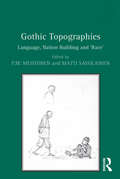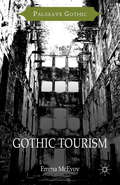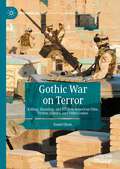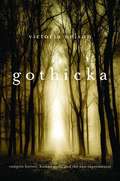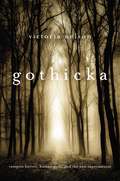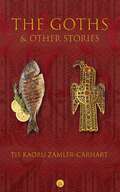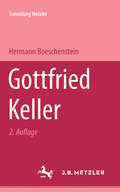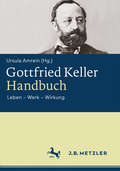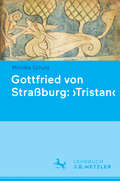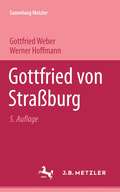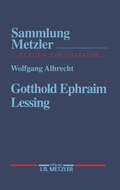- Table View
- List View
Gothic Topographies: Language, Nation Building and ‘Race’
by Matti SavolainenIn demonstrating the global reach of Gothic literatures, this collection takes up the influence of the Gothic mode in literatures that may be geographically remote from one another but still share related issues of minor languages, nation building, place and race. Suggesting that there is a parallel between certain motifs and themes found in the Gothic of the North (Scandinavia, Northern Europe and Canada) and South (Australia, South Africa and the US South), the essays explore the transgressions and confusion of borders and limits, whether they be linguistic, literary, generic, class-based, gendered or sexual. The volume includes essays on a wide diversity of authors and topics: Jan Potocki, Gustav Meyrink, William Godwin, Alan Hollinghurst, Marlene van Niekerk, John Richardson, antislavery discourse and the Gothic imagination, the Australian aboriginal Gothic, vampires of Post-Soviet Gothic society, Danish, Swedish and Finnish fiction and film, and the Canadian female Gothic and the death drive. What distinguishes this book from other collections on the Gothic is the coverage of themes and literatures that are either lacking in the mainstream research on the Gothic or are referred to only briefly in other book-length studies. Experts in the Gothic and those new to the field will appreciate the book's commitment to situating Gothic sensibilities in an international context.
Gothic Topographies: Language, Nation Building and ‘Race’
by Matti SavolainenIn demonstrating the global reach of Gothic literatures, this collection takes up the influence of the Gothic mode in literatures that may be geographically remote from one another but still share related issues of minor languages, nation building, place and race. Suggesting that there is a parallel between certain motifs and themes found in the Gothic of the North (Scandinavia, Northern Europe and Canada) and South (Australia, South Africa and the US South), the essays explore the transgressions and confusion of borders and limits, whether they be linguistic, literary, generic, class-based, gendered or sexual. The volume includes essays on a wide diversity of authors and topics: Jan Potocki, Gustav Meyrink, William Godwin, Alan Hollinghurst, Marlene van Niekerk, John Richardson, antislavery discourse and the Gothic imagination, the Australian aboriginal Gothic, vampires of Post-Soviet Gothic society, Danish, Swedish and Finnish fiction and film, and the Canadian female Gothic and the death drive. What distinguishes this book from other collections on the Gothic is the coverage of themes and literatures that are either lacking in the mainstream research on the Gothic or are referred to only briefly in other book-length studies. Experts in the Gothic and those new to the field will appreciate the book's commitment to situating Gothic sensibilities in an international context.
Gothic Tourism: Constructing Haunted England (Palgrave Gothic)
by Emma McEvoyFrom Strawberry Hill to The Dungeons, Alnwick Castle to Barnageddon, Gothic tourism is a fascinating, and sometimes controversial, area. This lively study considers Gothic tourism's aesthetics and origins, as well as its relationship with literature, film, folklore, heritage management, arts programming and the 'edutainment' business.
Gothic Vision: Three Centuries of Horror, Terror and Fear
by Dani CavallaroThe Gothic Vision examines a broad range of tales of horror, terror, the uncanny and the supernatural, spanning the late-eighteenth century to the present, and of related theoretical approaches to the realm of dark writing. It argues that such narratives are objects for historical analysis, due to their implication in specific ideologies, while also focusing on the recurrence over time of themes of physical and psychological disintegration, spectrality and monstrosity. This is an excellent overview of a genre that is increasingly studied in literature, film, and cultural studies courses.
Gothic War on Terror: Killing, Haunting, and PTSD in American Film, Fiction, Comics, and Video Games (Palgrave Gothic)
by Danel OlsonAfter 9/11, the world felt the “shock and awe” of the War on Terror. But that war also exploded inside novels, films, comics, and gaming. Danel Olson investigates why the paranormal, ghostly, and conspiratorial entered such media between 2002-2022, and how this Gothic presence connects to the most recent theories on PTSD. Set in New York/Gotham, Afghanistan, Iraq, and CIA black sites, the traumatic and weird works interrogated here ask how killing affects the killers. The protagonists probed are artillery, infantry, and armored-cavalry soldiers; military intelligence; the Air Force; counter-terrorism officers of the NYPD, NCIS, FBI, and CIA; and even the ultimate crime-fighting vigilante, Batman.
The Gothic World (Routledge Worlds)
by Glennis Byron Dale TownshendThe Gothic World offers an overview of this popular field whilst also extending critical debate in exciting new directions such as film, politics, fashion, architecture, fine art and cyberculture. Structured around the principles of time, space and practice, and including a detailed general introduction, the five sections look at: Gothic Histories Gothic Spaces Gothic Readers and Writers Gothic Spectacle Contemporary Impulses. The Gothic World seeks to account for the Gothic as a multi-faceted, multi-dimensional force, as a style, an aesthetic experience and a mode of cultural expression that traverses genres, forms, media, disciplines and national boundaries and creates, indeed, its own ‘World’.
The Gothic World (Routledge Worlds)
by Glennis Byron Dale TownshendThe Gothic World offers an overview of this popular field whilst also extending critical debate in exciting new directions such as film, politics, fashion, architecture, fine art and cyberculture. Structured around the principles of time, space and practice, and including a detailed general introduction, the five sections look at: Gothic Histories Gothic Spaces Gothic Readers and Writers Gothic Spectacle Contemporary Impulses. The Gothic World seeks to account for the Gothic as a multi-faceted, multi-dimensional force, as a style, an aesthetic experience and a mode of cultural expression that traverses genres, forms, media, disciplines and national boundaries and creates, indeed, its own ‘World’.
Gothic Writers: A Critical and Bibliographical Guide
by Douglass H. Thomson Jack G. Voller Frederick S. FrankWith its roots in Romanticism, antiquarianism, and the primacy of the imagination, the Gothic genre originated in the 18th century, flourished in the 19th, and continues to thrive today. This reference is designed to accommodate the critical and bibliographical needs of a broad spectrum of users, from scholars seeking critical assistance to general readers wanting an introduction to the Gothic, its abundant criticism, and the present state of Gothic Studies. The volume includes alphabetically arranged entries on more than 50 Gothic writers from Horace Walpole to Stephen King. Entries for Russian, Japanese, French, and German writers give an international scope to the book, while the focus on English and American literature shows the dynamic nature of Gothicism today.Each of the entries is devoted to a particular author or group of authors whose works exhibit Gothic elements, beginning with a primary bibliography of works by the writer, including modern editions. This section is followed by a critical essay, which examines the author's use of Gothic themes, the author's place in the Gothic tradition, and the critical reception of the author's works. The entries close with selected, annotated bibliographies of scholarly studies. The volume concludes with a timeline and a bibliography of the most important broad scholarly works on the Gothic.
Gothicka: Vampire Heroes, Human Gods, And The New Supernatural
by Victoria NelsonThe Gothic has taken a revolutionary turn in this century. Today’s Gothic has fashioned its monsters and devils into heroes and angels and is actively reviving supernaturalism in popular culture. Nelson argues that this mainstreaming of a spiritually driven supernaturalism is a harbinger of what a post-Christian religion in America might look like.
Gothicka: Vampire Heroes, Human Gods, And The New Supernatural
by Victoria NelsonThe Gothic has taken a revolutionary turn in this century. Today’s Gothic has fashioned its monsters and devils into heroes and angels and is actively reviving supernaturalism in popular culture. Nelson argues that this mainstreaming of a spiritually driven supernaturalism is a harbinger of what a post-Christian religion in America might look like.
The Gothic's Gothic (Routledge Revivals): Study Aids to the Tradition of The Tale of Terror
by Benjamin Franklin Fisher IVFirst published in 1988, this book aims to provide keys to the study of Gothicism in British and American literature. It gathers together much material that had not been cited in previous works of this kind and secondary works relevant to literary Gothicism — biographies, memoirs and graphic arts. Part one cites items pertaining to significant authors of Gothic works and part two consists of subject headings, offering information about broad topics that evolve from or that have been linked with Gothicism. Three indexes are also provided to expedite searches for the contents of the entries. This book will be of interest to students of literature.
The Gothic's Gothic (Routledge Revivals): Study Aids to the Tradition of The Tale of Terror
by Benjamin Franklin Fisher IVFirst published in 1988, this book aims to provide keys to the study of Gothicism in British and American literature. It gathers together much material that had not been cited in previous works of this kind and secondary works relevant to literary Gothicism — biographies, memoirs and graphic arts. Part one cites items pertaining to significant authors of Gothic works and part two consists of subject headings, offering information about broad topics that evolve from or that have been linked with Gothicism. Three indexes are also provided to expedite searches for the contents of the entries. This book will be of interest to students of literature.
The Goths & Other Stories
by Sasha Kaoru Zamler-CarhartIn the winter of 476 A.D. the Ostrogoths, hungry and exhausted from wandering for months along the barren confines of the Byzantine Empire, wrote to Emperor Zeno in Constantinople requesting permission to enter the walled city of Epidaurum and just kinda crash and charge their phones. Closer to home, Orpheus walks Eurydice through a suburban refrigerator as a matter of tax planning. In The Goths & Other Stories, sexual desire, food, space, and anger are distorted; prose fiction, experimental poetry, philosophy, and design theory intersect and breed. The poetics of car accidents, capitalist consumption, and anarchist terrorism unfold at a Southern California car dealership. Readers of all centuries will feel at home in this book. The smell of seafood and speculative urban planning merge into a 1990s computer game, Abidjan has 12,756 streets with no way to go from one to another, an apocalypse of tax law and classical mythology descends upon suburbia and reveals a medieval theology of design, theater, and light. The book’s six stories are set in different times and places – sometimes within the same narrative – but have in common a slippery approach to the boundaries between fiction and theory, between ontological planes, between the comical and the moral. Together they also form a treatise on the nature of writing as a branch of design – one whose medium is easier to reveal than to define.
The Goths & Other Stories
by Tis Kaoru Zamler-CarhartIn the winter of 476 AD, the Ostrogoths, hungry and exhausted from wandering for months along the barren confines of the Byzantine Empire, wrote to Emperor Zeno in Constantinople requesting permission to enter the walled city of Epidaurum and just kinda crash and charge their phones. Closer to home, Orpheus walks Eurydice through a suburban refrigerator, Abidjan has 12,756 streets with no way to go from one to another, and the poetics of car accidents, capitalist consumption, and anarchist terrorism unfold at a Southern California car dealership. Readers of all centuries will feel at home in this book, as an apocalypse of tax law and classical mythology quietly descends upon their living room and reveals a medieval theology of design, theater, and light. The Goths and Other Stories is a collection of short works at the intersection of prose fiction, experimental poetry, philosophy, and design theory. The book’s six stories are set in different times and places—sometimes within the same narrative—but have in common a slippery approach to the boundaries between fiction and theory, between ontological planes, between the comical and the moral. Together they also form a treatise on the nature of writing as a branch of design—one whose medium is easier to reveal than to define.
Gotta Have It (Mills And Boon Blaze Ser.)
by Lori Wilde"Cool, calm and collected" is how Abby Archer always thought of herself–on a down day she might even have used the word repressed. Well, not anymore.
Gottfried Benn: Ein Schriftsteller zwischen Erneuerung und Reaktion
by Hugh RidleyIn diesem Band bietet der Autor eine Übersicht über das lyrische, erzählerische und essayistische Werk Gottfried Benns. Auf einen einführenden, biographischen wie zeitgeschichtlich orientierten Teil folgt eine Untersuchung der Beziehungen von Benns lyrischem Frühwerk zur Dichtung der Jahrhundertwende, insbesondere zu Liliencron, Rilke und George. Einen weiteren Schwerpunkt bildet die Analyse seiner frühen Prosa, deren Erzählstruktur und spezifische Merkmale im Vergleich mit anderen expressionistischen Werken herausgearbeitet werden. Abschließend werden Aspekte von Benns Wiederentdeckung nach 1949 - nachdem er durch die Expressionismus - Debatte gebrandmarkt schien - erörtert.
Gottfried Keller-Handbuch
by Ursula AmreinMit seinen Romanen und Novellen gehört Gottfried Keller zu den bedeutendsten Autoren des Realismus. Walter Benjamin zählt ihn zu den »drei oder vier größten Prosaikern der deutschen Sprache« überhaupt. Doch nicht nur als Erzähler trat Keller hervor. Er wollte Maler und später Dramatiker werden, gewann als Lyriker erste Anerkennung, mischte sich in die Politik ein, schrieb Kunstkritiken und unterhielt ausgedehnte Korrespondenzen. Das Handbuch bringt Kellers Werk unter Berücksichtigung des Nachlasses erstmals in seinem ganzen Umfang zur Darstellung. Entlang der Schauplätze Zürich, München, Heidelberg und Berlin rekonstruiert es die Biographie des Autors und verortet sein Schaffen im kulturellen und politischen Kontext der Zeit. Mit Blick auf die Wirkungsgeschichte wird Keller darüber hinaus als Wegbereiter der Moderne erkennbar. Die Neuauflage enthält erstmals zahlreiche Abbildungen und eine Zeittafel.
Gottfried Keller-Handbuch: Leben – Werk – Wirkung
by Ursula AmreinKonsequent im Diesseits. Der grüne Heinrich , Die Leute von Seldwyla oder Kleider machen Leute mit seinen Romanen und Novellen gehört Gottfried Keller zu den wichtigsten Autoren des Realismus. Doch nicht nur als Erzähler, auch als Maler, Dichter, Publizist und Kunstkritiker trat er hervor; das zeigen die biografischen Schauplätze Zürich, München und Berlin. Interpretationen positionieren sein Werk im kulturellen und politischen Kontext des 19. Jahrhunderts. Umfassendes Handbuch über einen der größten Prosaiker der deutschen Sprache (Walter Benjamin)
Gottfried von Straßburg: 'Tristan'
by Monika SchulzGottfried von Straßburg ist neben Hartmann von Aue und Wolfram von Eschenbach der meistgelesene Autor im Studium der Älteren deutschen Literatur und sein 'Tristan' ist einer der vielschichtigsten Texte dieser Zeit. Dieser Band bietet eine übersichtlich strukturierte Gesamtdarstellung des 'Tristan', er erläutert seine zentralen Themen und Motive ausführlich und verweist jeweils auf wichtige Forschungsfragen. Bei der Analyse werden zudem Vergleiche mit den Vorläuferversionen von Berol, Eilhart von Oberg und Thomas von Bretagne geboten. Ein Schlusskapitel behandelt weiterführende Aspekte wie etwa Passion und Gender und die Rezeption bei den Fortsetzern Gottfrieds.
Gottfried von Strassburg (Sammlung Metzler)
by Gottfried Weber Werner HoffmannDichter ohne Spuren? Über Gottfried von Straßburg ist kaum Biografisches überliefert, nur dürftige Fakten zu seinem Werk sind gesichert. Gottfried Weber und Werner Hoffmann referieren aufgrund der kontroversen Deutung die unterschiedlichen Forschungspositionen und kennzeichnen die strittigen Probleme.
Gotthold Ephraim Lessing (Sammlung Metzler)
by Wolfgang AlbrechtLessing als Schlüsselfigur der Aufklärung. Vor dem Hintergrund Lessings Werdegangs stellt der Autor die Werke des Dichters in Einzelanlysen vor. Es entsteht ein geschlossenes Bild Lessings Gesamtwerks, das auch das historische Umfeld einbezieht. So werden die zentralen Strömungen sowohl der Epoche als auch in Lessings Denken und Schaffen sichtbar. Eine gelungene Einführung für Schule und Hochschule.
